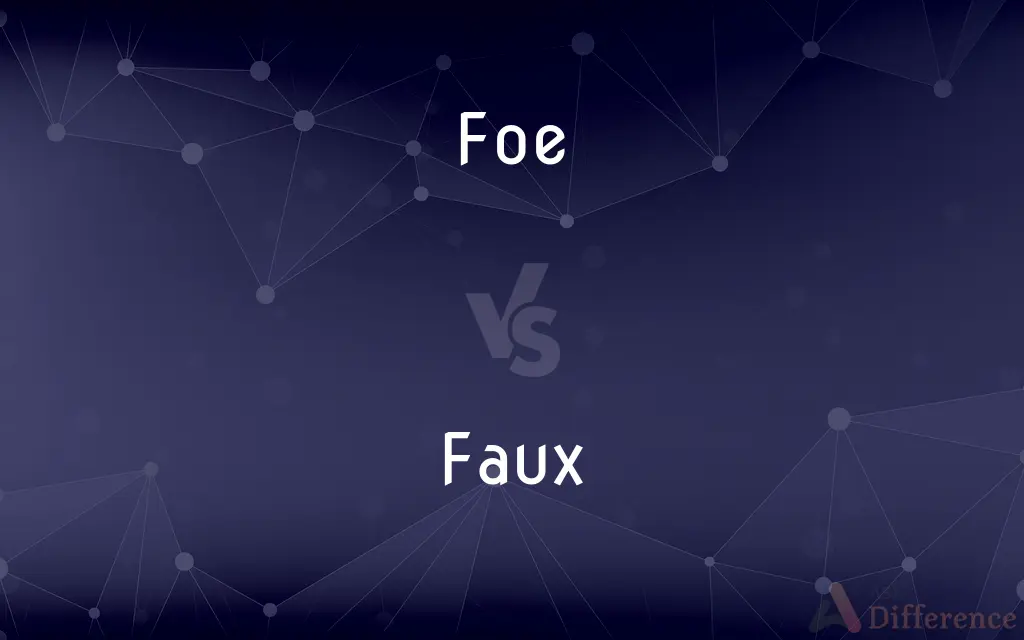Foe vs. Faux — What's the Difference?
Edited by Tayyaba Rehman — By Urooj Arif — Updated on April 23, 2024
"Foe" refers to an enemy, whereas "faux" denotes something false or imitation, such as faux fur.

Difference Between Foe and Faux
Table of Contents
ADVERTISEMENT
Key Differences
"Foe" specifically means an enemy or opponent, often used in contexts of conflict or competition. On the other hand, "faux" is used to describe an imitation or ersatz product, emphasizing its non-genuine nature.
In literature, "foe" is frequently used to describe a character's adversary, adding a dramatic element to narratives. Whereas "faux" might be employed to describe objects within a setting, such as faux leather couches, to subtly comment on authenticity and values.
The term "foe" evokes a sense of antagonism and rivalry, suitable for discussions of military, political, or personal opposition. Meanwhile, "faux" conveys a sense of artificiality and is often used in fashion and design to denote ethical or economical alternatives to authentic materials.
"Foe" is derived from the Old English "fāh," meaning hostile or at enmity, directly linking it to enmity. In contrast, "faux" comes from the French word for false, frequently used in English to describe artificially replicated aesthetics.
While "foe" carries a clearly negative connotation, suggesting direct conflict, "faux" can have a neutral or even positive connotation, particularly when used to describe products designed to be ethical alternatives, like faux fur in place of real fur.
ADVERTISEMENT
Comparison Chart
Definition
An enemy or opponent
Something fake or artificial
Usage Context
Conflict, war, opposition
Design, fashion, materials
Connotation
Negative, antagonistic
Neutral, sometimes positive
Derivation
Old English "fāh" (hostile)
French "faux" (false)
Common Phrases
Arch foe, sworn foe
Faux leather, faux fur
Compare with Definitions
Foe
A rival in sports or competitions.
The team faced their old foe in the championship.
Faux
Made to imitate something else.
The jacket was made of faux leather.
Foe
A figure of opposition in literature.
In many tales, the hero must overcome a powerful foe.
Faux
An alternative in design to reduce cost.
The builder used faux wood beams for the ceiling.
Foe
An antagonist in a conflict.
Negotiators tried to reach an agreement with their historical foes.
Faux
Used to describe ethical substitutes.
She preferred faux fur to avoid using animal products.
Foe
A personal adversary.
He considered anyone obstructing his progress a foe.
Faux
Artificial or decorative in nature.
The party featured faux antique decor.
Foe
An enemy or opponent
His work was praised by friends and foes alike
Faux
Not genuine or real.
She wore a faux diamond necklace.
Foe
A personal enemy or opponent.
Faux
Made in imitation; artificial
A faux-fur jacket
A rope of faux pearls
Foe
One who is opposed to an idea or cause
A foe of tax reform.
Faux
Artificial; fake
Faux pearls.
Foe
An enemy in war.
Faux
Or artificial.
Foe
Something that is destructive or injurious
Taxes that were the foe of economic development.
Faux
See Fauces.
Foe
(obsolete) Hostile.
Faux
Not genuine or real; being an imitation of the genuine article;
It isn't fake anything; it's real synthetic fur
Faux pearls
False teeth
Decorated with imitation palm leaves
A purse of simulated alligator hide
Foe
An enemy.
Foe
A unit of energy equal to 1044 joules.
Foe
One who entertains personal enmity, hatred, grudge, or malice, against another; an enemy.
A man's foes shall be they of his own household.
Foe
An enemy in war; a hostile army.
Foe
One who opposes on principle; an opponent; an adversary; an ill-wisher; as, a foe to religion.
A foe to received doctrines.
Foe
To treat as an enemy.
Common Curiosities
What are some common products described as "faux"?
Common faux products include faux fur, faux leather, and faux wood.
What is the origin of the word "foe"?
"Foe" originates from the Old English "fāh," meaning hostile.
What does "foe" mean in a historical context?
In historical contexts, "foe" refers to an enemy in war or conflict, often between nations or groups.
Can "foe" and "faux" be used interchangeably?
No, "foe" and "faux" cannot be used interchangeably as they refer to entirely different concepts.
Are there ethical implications associated with using "faux" products?
Yes, using "faux" products is often seen as an ethical choice, particularly in avoiding animal products.
What literary roles does a "foe" play in stories?
In literature, a "foe" typically serves as the antagonist or challenger to the protagonist.
How is "faux" used in the fashion industry?
In fashion, "faux" describes artificial materials that imitate natural ones, like faux fur or faux leather, often for ethical or cost reasons.
Is "faux" considered a negative term?
"Faux" is not inherently negative and can be positive, especially when referring to ethical alternatives.
What psychological impact might a "foe" have in competitive environments?
A "foe" in competitive environments can increase motivation and focus but also raise stress and aggression levels.
Why might someone choose a faux item over a real one?
Reasons include ethical considerations, cost reduction, and maintenance ease.
Can "foe" be used in a non-literal sense?
Yes, "foe" can be used metaphorically to describe anything considered an obstacle or opposition.
How does "faux" impact environmental considerations?
"Faux" products can be both positive and negative for the environment, depending on production processes and materials used.
How does the use of "faux" influence consumer perception?
"Faux" can influence consumer perception by offering a sense of style and responsibility without compromising on ethics.
What are historical examples of famous foes?
Historical examples include figures like Napoleon and Wellington.
How has the usage of "faux" evolved over time?
The usage of "faux" has expanded, particularly in fashion and home decor, as technologies for imitating materials have improved.
Share Your Discovery

Previous Comparison
Whine vs. Wine
Next Comparison
Bereaved vs. BereftAuthor Spotlight
Written by
Urooj ArifUrooj is a skilled content writer at Ask Difference, known for her exceptional ability to simplify complex topics into engaging and informative content. With a passion for research and a flair for clear, concise writing, she consistently delivers articles that resonate with our diverse audience.
Edited by
Tayyaba RehmanTayyaba Rehman is a distinguished writer, currently serving as a primary contributor to askdifference.com. As a researcher in semantics and etymology, Tayyaba's passion for the complexity of languages and their distinctions has found a perfect home on the platform. Tayyaba delves into the intricacies of language, distinguishing between commonly confused words and phrases, thereby providing clarity for readers worldwide.














































